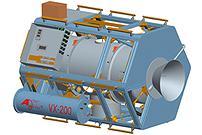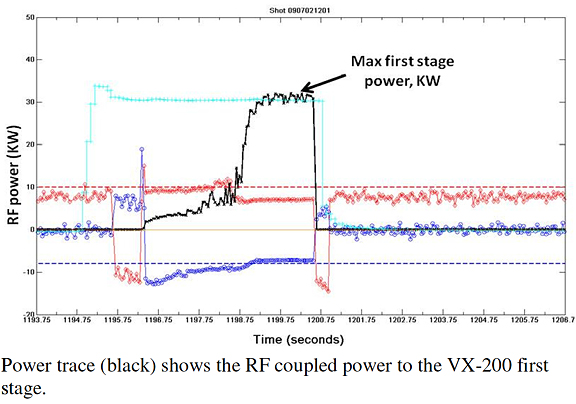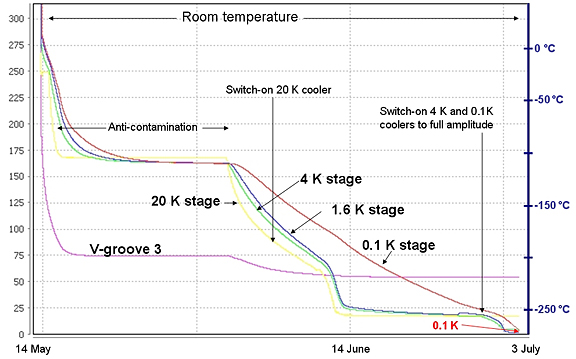|
|||||||
|
|
|
 |
|
|
Strumenti |
|
|
#201 | |
|
Senior Member
Iscritto dal: Apr 2006
Messaggi: 1464
|
Prosegue lo sviluppo di VASIMR:
Quote:
|
|
|
|

|
|
|
#202 | |
|
Senior Member
Iscritto dal: Apr 2006
Messaggi: 1464
|
Nuovi sviluppi anche per i pannelli solari:
Quote:
|
|
|
|

|
|
|
#203 |
|
Senior Member
Iscritto dal: Mar 2002
Città: Treviso
Messaggi: 911
|
Il VASIMR finalmente funzionante!
avranno però i loro bei grattacapi a schermare tutte le apparecchiature di bordo dalle microonde emesse dal motore! per chi volesse info: http://en.wikipedia.org/wiki/VASIMR |
|
|

|
|
|
#204 | |
|
Senior Member
Iscritto dal: Mar 2002
Città: Treviso
Messaggi: 911
|
novità anche dall' ESA:
Quote:
|
|
|
|

|
|
|
#205 | |
|
Senior Member
Iscritto dal: Apr 2006
Messaggi: 1464
|
Quote:
Riguardo alle missioni in collaborazione mi auguro che si segua la consuetudine del JPL (dati disponibili "subito") e non quella dell'ESA (3 foto in croce e il resto dopo x mesi). |
|
|
|

|
|
|
#206 | |
|
Senior Member
Iscritto dal: Nov 2003
Città: Utopia Planitia
Messaggi: 3875
|
Anche se ormai non c'é più da sperare metto a conoscenza del progetto: Terrestrial Planet Finder
Quote:
__________________

|
|
|
|

|
|
|
#207 | |
|
Senior Member
Iscritto dal: Apr 2006
Messaggi: 1464
|
Per la serie sonde robuste
 Quote:
|
|
|
|

|
|
|
#208 | |
|
Senior Member
Iscritto dal: Apr 2006
Messaggi: 1464
|
Parlando invece di sonde (molto) fredde l'High Frequency Instrument di Planck ha raggiunto la sua temperatura operativa di 0.1 K:
Quote:
|
|
|
|

|
|
|
#209 |
|
Senior Member
Iscritto dal: Apr 2006
Messaggi: 1464
|
Il Corriere spaccia Amstrong e Collins come morti quando invece sono vivissimi:
Corriere: Neil Armstrong e Michael Collins dell'Apollo 11 sono morti (ma da che fonti partono per scrivere queste notizie?) |
|
|

|
|
|
#210 | |
|
Senior Member
Iscritto dal: Mar 2002
Città: Treviso
Messaggi: 911
|
Quote:
|
|
|
|

|
|
|
#211 |
|
Senior Member
Iscritto dal: Sep 2004
Messaggi: 1258
|
Grande Fratello marziano!
Il "grande fratello marziano", dopo 105 giorni, è terminato:
http://www.wired.it/news/archivio/20...4/mars500.aspx http://www.esa.int/esaCP/SEMIS47CTWF_index_0.html Vi è mai passato per la testa che forse DAVVERO anche il GF "terrestre" è seguito con interesse da psicologi di NASA e ESA per capire i meccanismi che si innescano in un gruppo di giovani costretti a convivere per 3 mesi in uno spazio chiuso comune?
__________________
La scienza è provvisoria -- Jumpjack -- |
|
|

|
|
|
#212 |
|
Senior Member
Iscritto dal: Apr 2006
Messaggi: 1464
|
|
|
|

|
|
|
#213 | |
|
Senior Member
Iscritto dal: Apr 2006
Messaggi: 1464
|
Il giornale: Allunaggio: 1969-2009 Un’impresa spettacolare che sembra quasi finta...
Riporto il commento di Attivissimo che risponde alle solite domande poste nell'articolo: Quote:
|
|
|
|

|
|
|
#214 | |
|
Senior Member
Iscritto dal: Apr 2006
Messaggi: 1464
|
Quote:
|
|
|
|

|
|
|
#215 | |
|
Senior Member
Iscritto dal: Apr 2006
Messaggi: 1464
|
Quote:
|
|
|
|

|
|
|
#216 |
|
Senior Member
Iscritto dal: Sep 2004
Messaggi: 1258
|
La sonda LRO fotografa le missioni Apollo
http://www.nasa.gov/mission_pages/LR...ollosites.html
 LARGE--> http://www.nasa.gov/images/content/3...ollo11_lrg.jpg  NOTA: l'orbita non è ancora stabile, quindi ha quota variabile, percio' foto di siti diversi hanno risoluzioni diverse.
__________________
La scienza è provvisoria -- Jumpjack -- |
|
|

|
|
|
#217 | |
|
Senior Member
Iscritto dal: Dec 2002
Messaggi: 5986
|
Quote:
__________________
Steam : azatoth81 Nikon D610 + Tamron SP 24-70mm F/2.8 Di VC USD + Nikkor 105 Ai F/2.5 + Nikkor 50 AF-S F/1.8 |
|
|
|

|
|
|
#218 |
|
Senior Member
Iscritto dal: Apr 2006
Messaggi: 1464
|
|
|
|

|
|
|
#219 | |||
|
Senior Member
Iscritto dal: Mar 2002
Città: Treviso
Messaggi: 911
|
Quote:
Utilizza le microonde per ionizzare il gas e accelerarlo con un campo magnetico generato con un magnete a superconduzione. dalla pagina di wikipedia: Quote:
dalla pagina di wikipedia: Quote:
|
|||
|
|

|
|
|
#220 |
|
Senior Member
Iscritto dal: Apr 2006
Messaggi: 1464
|
Gli RTG sono troppo poco efficienti. L'unica soluzione realistica in quei casi è un qualche tipo di reattore nucleare.
|
|
|

|

|
| Strumenti | |
|
|
Tutti gli orari sono GMT +1. Ora sono le: 21:42.





























